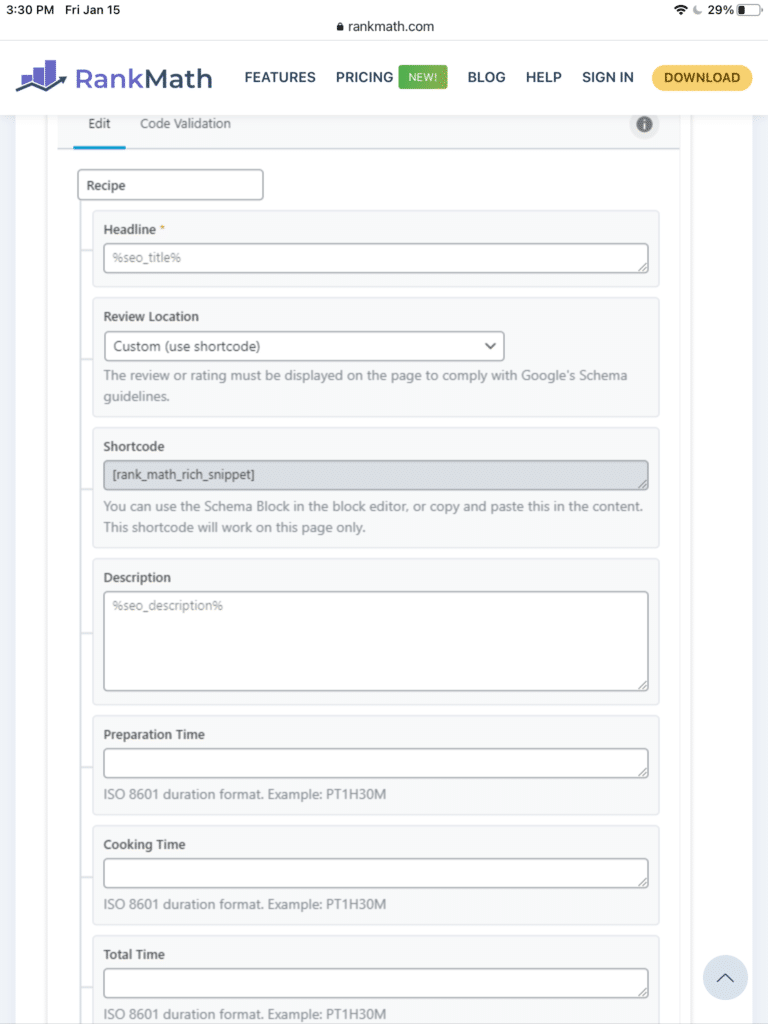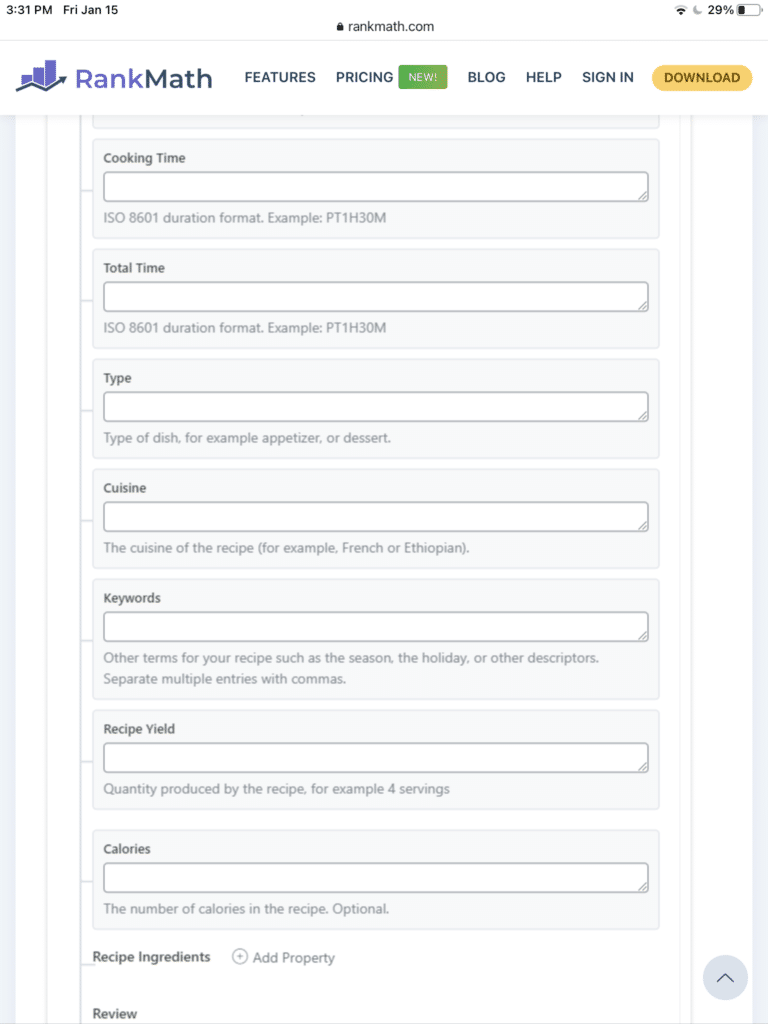Learn how to blog like a pro – for free
Learn how to blog like a pro and catapult your ranking. When you learn to blog the right way, you can serve your audience and help your content rise through the rankings to the first page of Google.
- Why do we say that content is king?
- Research user intent
- Know your topic
- How do I do original research for my blog posts?
- Use an SEO plugin to optimize your posts
- Write headlines that help users
- What are long tail keywords?
- Should I use longtail keywords in my headlines?
- Research your competitors' keywords
- Is page length a ranking factor in blogging?
- What is a pillar post?
- What is schema and how should I use it?
- What are Google rich snippets?
- How do I create a rich snippet?
- What are Google featured snippets?
- How does Google know what to pull?
- What is that snippet preview thing in my SEO all about?
- Which factors does Google use to determine ranking?
- What is page authority?
- How important is getting backlinks to boost your ranking in 2021?
- Should I use Elementor or Gutenberg when blogging?
- How do I actually blog like a pro?
- Is there a template for a great blogpost?
- How do I write the body of my text?
- How do I optimize my content for voice searches?
- Should I use text to speech software on my blog posts?
- How do I monetize my blog?
- What is off-page SEO?
- What is Google Search Console?
- Summary
Why do we say that content is king?
When learning to blog like a pro the most important thing to remember is that content is king. As search engines get smarter, they can understand user intent, that is, the meaning behind searches. Search engines are now about answering questions. Therefore, your articles need to answer users’ questions or solve their problems.
Research user intent
Before you sit down to write, ask the following questions:
- Who is this post targeted at?
- What are their pain points?
- How can I solve their problems?
Then, you can figure out what kinds of questions users are asking by using various tools like Answer the Public or by using Google in organic searches. Simply type in a topic into the search bar and see which questions are associated with that topic. Those questions will appear in the People also ask section in Google. Scroll further to the bottom of the page to see related searches.
Know your topic
The best way to serve users and write great posts is to really know your topic. You don’t want to be repeating the same information as everyone else in your industry. To do so, you can use:
- Your personal knowledge of the topic
- You can read everything related to the topic, including specialist materials
- You should listen to various podcasts, watch YouTube tutorials, and take seminars related to your topic to keep your knowledge up to date
You can write a post that is better than everyone else’s and elevate it by using charts, infographics, and videos. You will, of course, use links to cite any original sources you quote from for further reading. You can take it one step further by including original research.
How do I do original research for my blog posts?
- Interview people in your industry. An example of this is when doctors are quoted about various medical procedures. It carries much more weight when an expert opinion substantiates your post
- Gather statistical information that your competitors haven’t delved into
- Poll an audience from a FaceBook Group
- Send surveys to your mailing list
Use an SEO plugin to optimize your posts
There’s Yoast and there’s RankMath. RankMath is better out of the box and I prefer it by far. RankMath will actually helps you become a better blogger with its intelligent suggestions and prompts. The free RankMath plugin integrates with both Gutenberg and Elementor, included schema from its inception, allows you to indicate whether a post is a pillar post or not, and includes a snippet feature.
Yoast, which has been in play since 2010 has only added schema and Elementor integration to its free plugin in 2020. Kinsta features and excellent side by side analysis here.
Write headlines that help users
Help your users understand what the content is about. Your headlines should be descriptive and if possible, catchy. RankMath has created a list of power words that will help you to write good headlines: The art of writing headlines. Please remember, readers are sophisticated these days and smarmy copy and clickbait headlines will turn them off. You want to be genuinely helpful and informative.
What are long tail keywords?
Long tail keywords are targeted search phrases that are narrower than those used in a broad search. For example, men’s jackets vs certain types of men’s jackets, such as weather proof men’s jackets for boating and fishing. The best way to find these long tail keywords is:
- Through an organic Google search. When you type in a term, Google will auto fill with a number of options
- Through Google’s related searches found at the bottom of the page
- Through a tool like Ubersuggest, which will suggest related terms that are being searched
- Through Answer the Public, which brings up questions being asked around the topic. Answer the Public gathers data by country, as well.
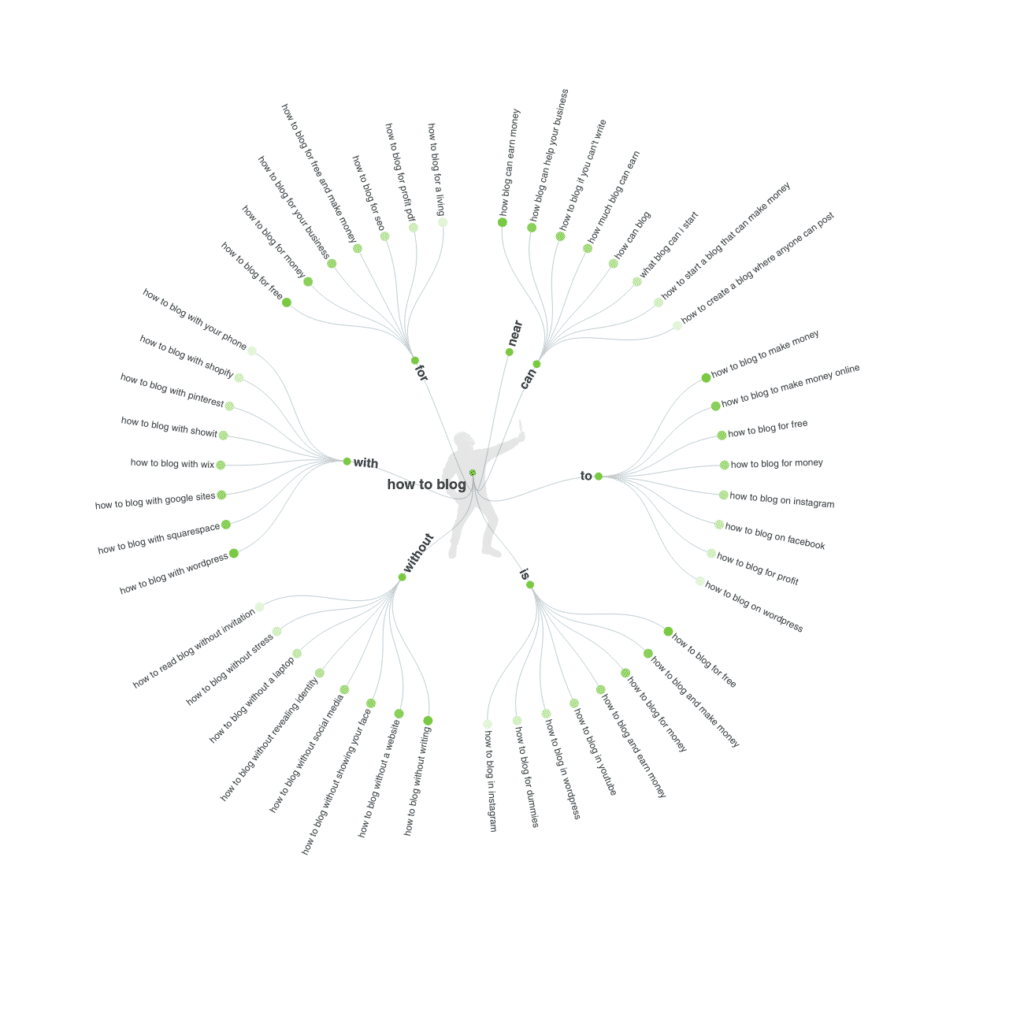
Should I use longtail keywords in my headlines?
You should use your keyword phrase in the following areas:
- Post title
- Snippet or meta description
- First paragraph of your content
- In one or more of your headings
- In an image -use it in the alt text section and in the image file name and title
- A few times in the body of your text
- In your conclusion
Research your competitors’ keywords
Theoretically, you should be able to find keywords that have high search volume and that your competitors have not fully exploited. If that is impossible, you have to look for the keywords they are ranking for and then outperform them with the quality of your posts. You can use Ubersuggest to discover that information.
Is page length a ranking factor in blogging?
Google says satisfying user intent is the main objective. However, analysis has shown that Google prefers longer content with around 2000 -2400 words.
What is a pillar post?
A pillar post, or pillar content, is a long, comprehensive post around which shorter posts are organized. A pillar post should be between 2000 -5000 words. The pillar content on this website is found on these pages:
- Building a branded website
- Choose the best color palette for your website
- Choose the best fonts for your website
- How to design your website layout
- Choose the best brand images for your website
- How to make a WordPress website
The other posts on this website are organized around those pillar pages and focus on shorter topics.
What is schema and how should I use it?
Schema helps search engines by providing more information about your post. When people are looking for certain information, schema will help them find it. Regarding posts, schema tells search engines what type of post it is. Using the schema feature that you added with your SEO plugin, you can choose the type of post you are featuring. For example, the RankMath PRO SEO plugin gives the following options:
- Article
- Book
- Course
- Event
- Job Posting
- Product
- Music
- Person
- Recipe
- Restaurant
- Video
- Service
- Software application
What are Google rich snippets?
This is what gives Google more information about your site. When you Google a product, service, company, recipe or person, the more information Google displays below the item searched for, the better the chances of getting traffic. The easiest way to do this is to use an SEO Plugin, like RankMath and configure the schema properly.
The scallop recipe below gives the cook time, calorie count, rating, and associated recipes.
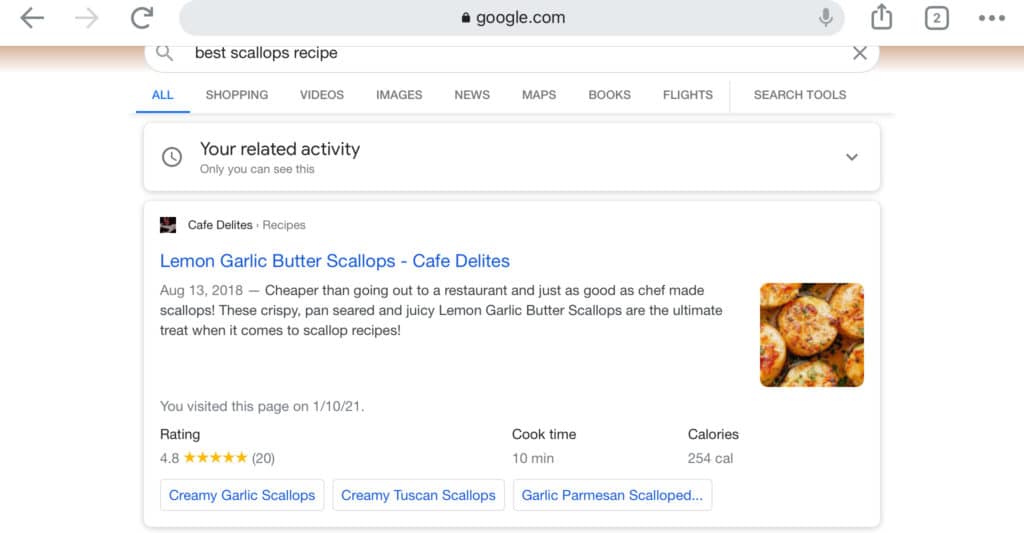
How do I create a rich snippet?
The simplest way is to use an SEO plugin that allows you to configure rich snippets properly. You simply choose the schema type and then complete the information. For example, recipe.
What are Google featured snippets?
Featured snippets answer a user’s question right away. They are featured right at the top of the organic (not paid) search results. Featured snippets are the easiest and fastest way to get to the top of the first page and increase traffic. There are three types of featured snippets:
- A list that answers the question. It can be numbered or bulleted
- A table that answers the question
- A three to four sentence answer that addresses the question directly
- A video from YouTube. Google owns YouTube, which is why you see relevant videos in organic results
The most popular type of snippet with users is the paragraph format. SEMRush analyses show that 40-52 words is optimal. Will you get featured in snippets if you don’t rank highly in the first place? You might. Google never reveals the precise nature of its algorithms, so do your best to write a great answer.
How does Google know what to pull?
Directly from Google: ‘Google’s automated systems determine whether a page would make a good featured snippet to highlight for a specific search request.’ You cannot mark anything on your page as a featured snippet.
What is that snippet preview thing in my SEO all about?
This is what people will see in search results. It consists of :
- SEO title – This is the title of the page that people see in search results and the link they will click. It is also what appears in the search bar at the top of your page or post. It is not necessarily the same as your H1 tag. There is some differences of opinion as to whether the title of a post and the SEO title should be the same or different. There is no consensus other than they should both help the user understand what the page or post is about.
- The meta description is the visible description of the page. You will want to make it as enticing as possible without writing click bait.
- The slug/ breadcrumb/ url – It varies, depending on what Google is experimenting with. The only thing you can change is the slug. Let Google pull it automatically.
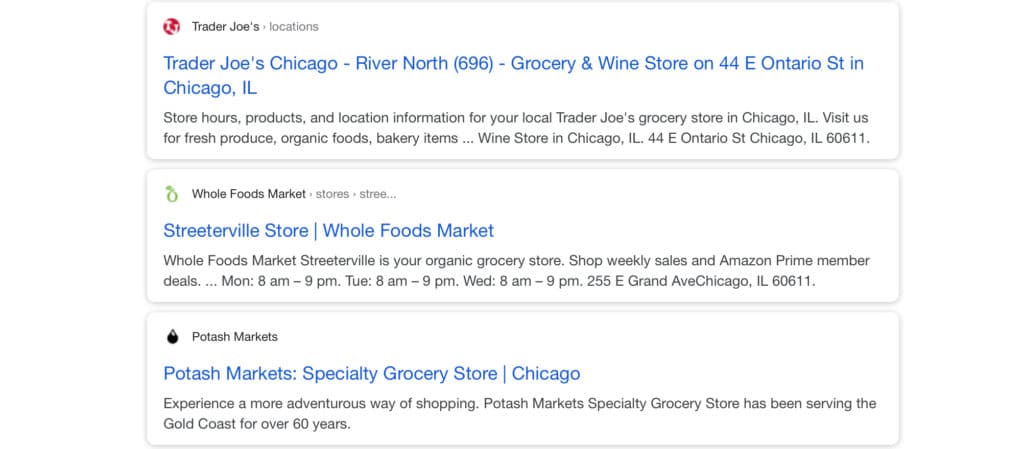
Which factors does Google use to determine ranking?
Google has updated its algorithm and it is looking for great user experience on the page or website. A great user experience is indicated by the user staying on your pages. Aside from creating quality content and having a well designed, beautiful website you need:
- A responsive website that looks and functions well on mobile devices
- Fast loading pages
- Security certificates – make sure your website is https and not http
- No intrusive ads or pop – ups
- Visual stability – the content shouldn’t be shifting around the page as it is loading
- No malicious or deceptive malware
What is page authority?
Authority measures the quality of a website or a page /post and predicts the visibility of that website or page based on certain metrics. These metrics were devised by the software provider Moz.
- Domain authority measures the quality of the overall website
- Page authority measures the quality of the page
In the past, we got authority by:
- Creating high quality content with a tight internal linking structure
- Getting high quality inbound links
Now we add branding to boost visibility, as well.
How important is getting backlinks to boost your ranking in 2021?
Google has always placed value on the backlink profile of a site. That is, the links that a website or page gets from authoritative websites. Links from authoritative websites help boost visibility. Many bloggers will focus on building relationships with other prominent bloggers in their field in order to exchange links. Concurrently, bloggers try to pitch ideas to prominent online publications to get featured guest post articles with a link back to their site.
This can be a time consuming and futile effort. In the past few years, many bloggers have had more success in creating easily digestible content such as an infographic that would be shared widely and get many backlinks. However that strategy is not working as well any more. Google, in its latest update has stated that they want to see natural links to content accrue over time. If you are getting too many links from authoritative sites in too short a time, they will consider that approach to be manipulative. What they want to see is high quality content being shared organically.
SemRush, a digital suite of tools that helps with market insights and SEO, has explained what is and isn’t working in 2021 in detail here Link building for SEO. You will need to develop a strategy that will work for you and be ready to pivot if your tactics don’t work.
Should I use Elementor or Gutenberg when blogging?
I recommend using Elementor Pro to build your pages and Gutenberg for the blog portion of your website. Gutenberg loads slightly faster and is an open source technology married to WordPress. It will never disappear nor will you have to pay for upgraded features. Add The Ultimate Addon Blocks and the Gutenberg slider plugins for more functionality.
Gutenberg is getting better and better. It has simple drag and drop features, or rather, click and pick features sucn as:
- Headings
- Paragraphs
- Images
- Video
- Lists
- Quotes
- Tables
- Buttons
- Columns
- Spacers
- Tons of embeds from web stories to Vimeo
How do I actually blog like a pro?
Write as if you are speaking to a good friend who is a beginner in your field. If you are a terrible writer, then talk into a tape and use a transcribing software to get everything into print. I’ve been blogging since 2012. These days I write for skimmers with no extraneous fluff in the text. I use lots of bullet points to create easy to digest material. However, your voice needs to be tailored to your audience. If you are writing for the beauty industry, for example, you will have to use a soft, nurturing tone of voice, or a friendly upbeat one, depending on your branding. In contrast, a technical or business blog will use a more professional tone of voice. To learn more about branding, please read Building a branded website . Regardless of your content, utilize the following:
- Write useful headlines
- Break up your content into short digestible paragraphs
- Write at an 8th grade reading level with no jargon
- Take the dates off your blog posts to keep them evergreen
- After a year, take a look at your most visited pages and then refresh or update your content on that page
Is there a template for a great blogpost?
How do I write the body of my text?
It takes practice to get the hang of writing a decent post. You can begin with these simple steps:
Outline
Break down the subject into several main headings and then a number of sub headings. Under each subheading list the points you want to cover in that section or paragraph.
Use the points you have listed to create sentences. Tie the sentences in with a transitional word. This method will teach you to write in the most economical style possible, conveying your ideas in a succinct and forthright manner.
Diagram
Before you begin writing your post, you can diagram your post topics to see how the parts will relate to the whole. Group the topics that belong together so that they flow into one another logically.
Lay it out on a big piece of paper
Whether you write or diagram, do it one huge piece of paper, so that you won’t lose track of essential matter by having everything in clear sight.
Write
- Pretend you are writing for someone who knows nothing about the topic
- Use your headings and develop, or explain, them in a few sentences
- Now put the sentences in each section into order. Do they seem cohesive? Does one sentence follow another logically? If so keep the sentences. If not, cut and paste the sentences that don’t work below the post, reserving them for another section, if necessary
- Do those sentences seem crisp or are they running on? If so, truncate them and use the necessary punctuation
- Make certain your tense structure is compatible throughout
- If you are still having trouble, ask someone else to read it. A second pair of eyes will be able to find things which may have escaped you
- Reading professionally written blogs will make you a much better and more skillful writer. If you are having problems, look to examples
- Sit on your post for a week. You’ll find you can improve it when your eyes are fresh
Use tools to help you write
- Grammarly goes beyond spelling and grammar to help you choose the right words, improve your style and eliminate errors. The free plan, which you can add to Chrome will give you: spelling, grammar, punctuation and conciseness. The Premium version will include everything in free, plus sentence rewrites, a plagiarism detector, word choice, tone adjustments and much more.
Practice
Once you begin writing your text, you will undoubtedly deviate from your outline. Don’t hesitate to follow your instincts, and feel free to change things around. As you progress, you will be able to throw these crutches away and let your writing flow spontaneously. Your capabilities may be limited at present, but you can be sure that you will get better the more you write.
How do I optimize my content for voice searches?
People type differently than they speak. As more and more people are conducting searches from smart devices, you will need to tailor your content to the way they speak. Therefore, when writing your content use the following:
- Long tail keywords
- A question and answer format
- A conversational tone
- If you have a local business, fill in your Google business page profile and include your location along with a Google map somewhere on your website
Should I use text to speech software on my blog posts?
It depends what kind of blog you have. Right now text to speech works best on news blogs. I tried a text to speech plugin recently and it didn’t pause between headings and paragraphs. It read very quickly, and there was no sense that it was reading lists. Rather, it sounded like a bunch of run on sentences.
How do I monetize my blog?
- Offer a service that you can charge for
- Coaching or consulting
- Sell online classes
- Affiliate marketing
- Sell digital or physical products
- Charge for gated materials via VIP membership
- Take donations through Patreon
What is off-page SEO?
Off page SEO is everything you and/ or other people do to promote your website or blog. It’s all the measures taken off site to promote your rankings. For example:
- Social media promotion
- Backlinks – when people link to your material
- Brand mentions – when people reference your brand but dont add a link
- Google My Business profile
What is Google Search Console?
Formerly known as Google Webmaster Tools, Google Search Console is a free service offered by Google to website owners. By using it, you can see how your website is performing and what you can do to fix problem issues.
You can learn how to use it by watching Google’s training videos.
Summary
A great deal of your success in blogging will consist of search engine optimization, or SEO, outlined in the steps above. You will need to do the following:
- Identify your audience and their pain points
- Tell them how you will resolve their problems
- Take your post step by step
- Research and use long tail keywords
- Break up your material into bite size paragraphs under the proper headings
- Answer questions and resolve problems succinctly
- Use an SEO plugin to optimize your content
- Use beautiful images, helpful videos, slideshows, charts, and infographics to enhance your posts
- Make sure your content works well on mobile devices
- Improve the loading speed of your pages
- Promote your content
- Update and keep your content evergreen

